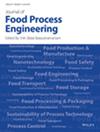This study evaluated the efficacy of cooking processes in natural and forced convection systems, for ensuring microbiological safety in industrial-scale ham production. The cold point of the tanks was determined by measuring the water temperature every 2 min, with a maximum variation of 1.4°C between different regions of the tanks. The calculation of the lethal value (Fcal) was carried out using Enterococcus faecalis as the target microorganism due to its high resistance to heat treatment. The cooking temperature was measured at the geometric center of the ham and, in both convection systems, it reached the Fref value (23.6 min), necessary to achieve a reduction of 8 log (8 D), with Fcal of 45.7 and 45 min of cooking in the natural and forced convection systems. Both convection systems achieved microbial reductions exceeding 15-log cycles (15 D), surpassing regulatory requirements despite occasional core temperatures below standard thresholds. In both systems (natural and forced), the cold spot was found on the left side, at a lower height, and toward the front of the tank. After heat treatment, no microorganisms were detected in the ham cooked in natural or forced convection systems. Both systems (natural and forced convection) proved viable at an industrial scale, provided that appropriate cooking protocols are followed.
The practical applications of this study are significant for the food industry and regulatory bodies involved in food safety. These include quality assurance in ham production, food safety compliance, process optimization, risk mitigation, and guidance for industrial practices. Overall, this study has practical implications for improving food safety, quality control, and production efficiency in the ham industry. It fills a gap in validation studies on industrial-scale ham cooking, providing valuable information for industry stakeholders and regulatory bodies alike.


